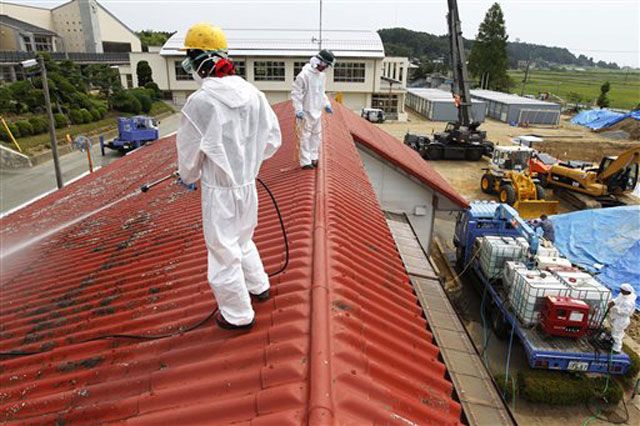You are here
Residents Near Fukushima Mountains Face Nuclear Recontamination Every Rainfall
Primary tabs
The Mainichi Daily News - October 12, 2011

Workers decontaminate radiation from the roof of Yasawa Kindergarten in Minami-Soma, about 12 miles (20 kilometers) away from the tsunami-crippled Fukushima Dai-ichi nuclear facility, in Fukushima prefecture, northeastern Japan, Thursday, Aug. 18, 2011. Photo - Associated Press (AP)
As the crisis at the Fukushima No. 1 Nuclear Plant drags on, worries are growing particularly among Fukushima Prefecture residents over drawn-out and in some cases apparently futile nuclear decontamination operations.
The unease is especially strong in areas in and around mountains that must be repeatedly decontaminated, as every rainfall brings a new batch of radioactive substance-contaminated leaves and soil washing down from the hills. Since some 70 percent of Fukushima Prefecture is mountainous, such instances of regular recontamination could occur over a broad area, while the same effect has also been observed in some undeveloped areas of cities.
The central government is considering paying for any decontamination operations conducted by local governments at sites with radiation emissions of 1 millisievert per year or more, but residents in places faced with regular recontamination after every major rainfall are concerned the national government may not keep the cleanup funding flowing.
The city of Fukushima decontaminated its Onami and Watari district in July and August after a surge in local radiation levels. In the week following the end of the operation, the city took fresh radiation readings at 885 points, of which seven actually registered levels exceeding those found before the decontamination. One gutter measured even showed a rise from 3.67 microsieverts per hour before the cleanup to 4.63 after the work.
"Radiation increased close to the mountains and in spots where water and soil washed down the slopes," the Fukushima Municipal Government stated.
One 52-year-old resident of the city's Onami district, whose home backs onto woodland slopes, told the Mainichi that soil washes into her backyard with every rainfall. Radiation emissions at her front door are 1 microsievert per hour or less, but in the backyard they're more than 2 microsieverts per hour.
"Everywhere around here is in the same situation," she says.
Meanwhile, a man living in the Watari district with his wife and his son's family discovered that the waterway running by his property had cesium levels of more than 300,000 becquerels after a citizen's group did tests in the area.
"There's no point in doing just one round of official decontamination," he told the Mainichi. "We residents will get nowhere near anything like peace of mind if decontamination operations can't be done regularly."
According to guidelines in a Ministry of Agriculture, Forestry and Fisheries study released on Sept. 30, removing fallen leaves and other natural forest debris from the area within about 20 meters of residential properties is effective in keeping contamination at bay. However, the guidelines also warn that "conifer needles also accumulate radioactive cesium over time, and can normally be expected to fall after three to four years," signaling a constant and long-term need to keep clearing properties of fallen needles.
The municipality of Fukushima has created a plan to bring radiation exposure in all inhabited areas of the city to below a microsievert per hour within two years. As part of this, cleanup operations will begin in the Onami district in October. No schedule has been set for decontaminating the city's mountains and forests, but the municipal government is considering removal of the leaf soil (soil made up of decaying leaves) within 75 meters of local properties, pending the consent of land owners -- significantly more than the forestry ministry's 20-meter guideline. It's thought that the decontamination process will have to go on for a long time to come, but the city has said it has yet to receive confirmation that financial support will continue to flow from the central government.
Furthermore, the problem of where to put all the contaminated material collected in the cleanups remains a serious headache. The central government has begun considering national forests as dump sites, but according to a disposal official in Date, Fukushima Prefecture, "'20 meters of forest' applied to every region here would be an enormous amount of material. Setting aside a site for that much soil is extremely difficult. On top of that, how could we secure enough workers to do the job?"
On top of concerns about the sheer volume of contaminated material and manpower, there is also the issue of the important natural roles played by forests, such as collecting water that eventually ends up as well water. The village of Kawauchi, removed from the emergency evacuation standby zone at the end of September, is almost 90 percent mountain forest, and depends on streams and well water for all its fresh water needs.
The village plans to decontaminate all the forest under its jurisdiction over the next 20 years, but "the village needs the forests to guarantee its source of fresh water," the decontamination project official said. "Is there no way to do decontamination while at the same time preserving the functions of the forest, without cutting down the trees?"
http://mdn.mainichi.jp/mdnnews/news/20111011p2a00m0na020000c.html



Recent Comments